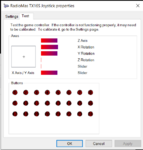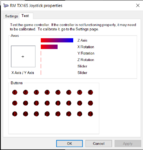Wow, Marcus and Flapper, thank you for all the advice.
Let me clarify that I did start with a blank model on the radio. The sticks are all -100% to +100%, no rates, no expo, no mixes. One of my previous comments about a switch for rates wasn't about changing the rates in the radio - it is just an input to RF, and RF applies its own rates.
I do have a WS2000. If I enable the RF multimodule and bind it to the WS2000, it works perfectly, but with the 8-channel limitation. If I then disable the RF multimodule and use the USB cable, with the same model on the radio, that is where my problems arise. When I plug in the USB cable, the radio asks if I want to use it as a USB Joystick or USB storage. After selecting USB Joystick, Windows recognizes it as a Game Controller, and its properties seem to indicate correct operation, as per joystick.png on in the first post. The switches may be mapped to different signals depending on how I happen to set it up (I've tried other configurations just to debug).
I uninstalled the HID-compliant game controller and deleted the radio profile in Documents. After plugging in the radio and right-clicking on its new HID-compliant game controller in the Device Manager, there is no 'game controller settings' option. But I can find it by searching the Win10 Home computer for 'Game Controllers.' The attached image shows the X/Y axis both centered. They are the aileron and throttle respectively. The Z axis is elevator, which is being held to full down, and the X rotation is the rudder. The elevator is being held up to illustrate that the X Rotation appears to be very close to 50%. This is really the crux of the matter - Windows seems to think the calibrations are all fine, but Realflight thinks the sticks are at 64% when they are physically centered.
Back into RF, you can't 'create' a new controller. It seems the only way to do that is to save an existing controller to a new name, delete all the stick and button assignments, and start over.
After doing this, and then calibrating, the same issue occurs. In the RF calibration, the sticks are at 50% until I calibrate them, at which point they think the center is 64%. And at least one of the sticks affects at least one other channel - I think it's rudder to flaps.
Marcus makes an excellent point about how many channels it takes to control RF. I'd like to have:
- Throttle
- Aileron
- Elevator
- Rudder (You can tell I came from Spektrum land with this channel order)
- Flaps
- Rates/Expo
- Smoke/gear/guns (all one channel in RF)
- Reset
And hey, those fit into 8 channels! 7, if you do rates in the radio. And as Marcus also points out, different modes can be set in the radio for planes and helis, etc. My stretch goal was to include the select, cancel, up, and down functions to enable selecting an aircraft from the controller. But maybe there aren't good button or switch options, particularly for the up/down functions. The select and cancel functions want to be momentary contact, as does the reset button. Since model select functions are used much less frequently than the actual flight controls, maybe it isn't too much to ask to reach for the keyboard and mouse. But on an actual Interlink controller, selecting a model is much nicer.
At this point I'm going to use the WS2000. It provides all the functionality I need, except for the nice model select functions, and has the bonus of being wireless. But as an engineer, it bothers me not to be able to have the option of using the USB connection with the higher number of possible functions.
Thank you Flapper and Marcus for your help!
Howard





